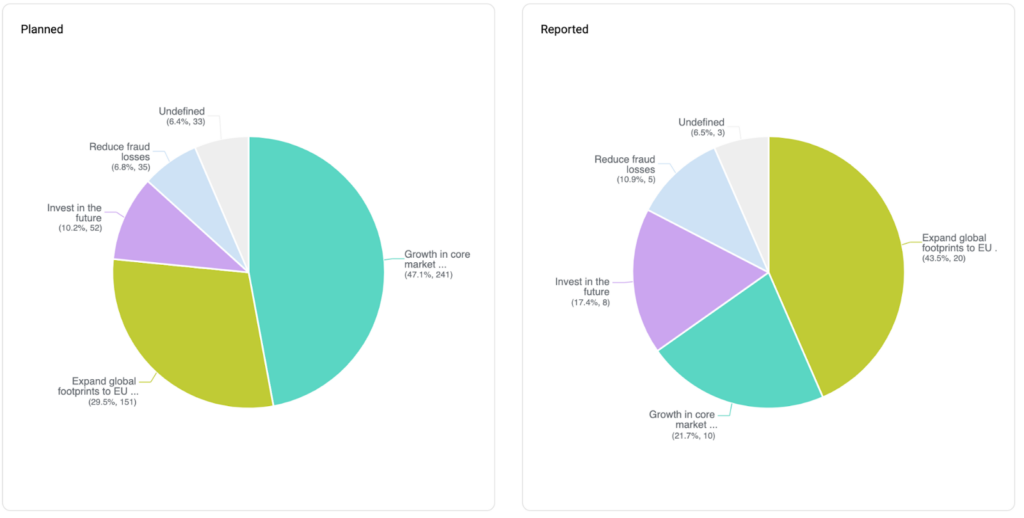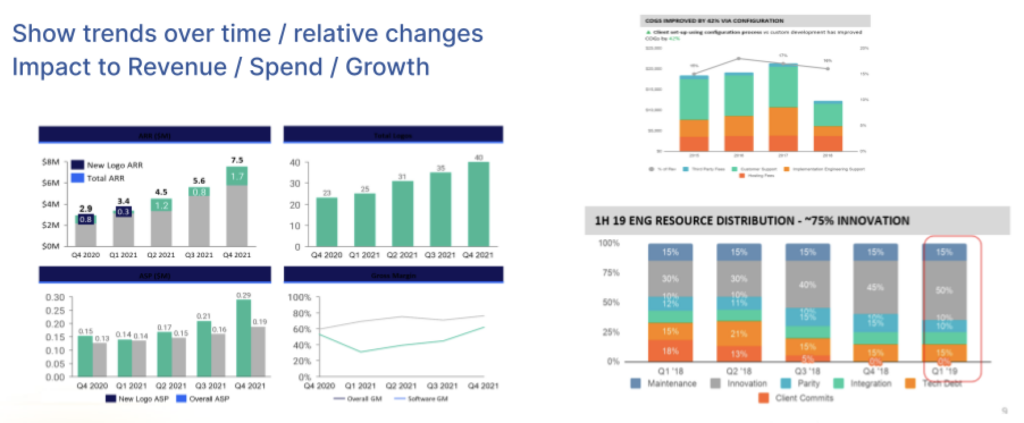As a key executive team member working closely with the CEO and Board, the Chief Product Officer (CPO) is focused on leading the product organization to drive outcomes.
It’s no secret that every C-Suite executive creates their own go-to dashboards that become their mission control center. Chief Revenue Officers look at pipeline and forecast reports, Chief Marketing Officers have lead and funnel reports, and Chief Operating Officers reviews reports covering all aspects of their organization’s product operations.
This begs the question: What are the top reports CPOs use to run their product operating model?
Through working with thousands of Chief Product Officers, we found out a common theme. And they are quite consistent with recommendations from these world-class CPOs.
There are five categories of reports every Chief Product Officer should have access to in order to ensure the effectiveness of their product operating model.
- The state of the product business: Outcome progress and roadmap progress
- The state of investment: Portfolio allocations (target vs actual)
- The state of portfolio decisions: strategic and tactical roadmaps from multiple angles
- The state of execution: Say:Do Ratio at the portfolio and team level
- A window into Risks and Bottlenecks
Let’s take a closer look at the top reports CPOs use.
The State of The Product Business
“Chief Product Officers need to have business talks, not just product talks. CPOs need to tie business Metrics With Roadmaps”
Shelley Perry Partner at Scalelogic, Former Chief Product Officer at NTT
This means CPOs need to closely connect their product goals with business goals and track key business metrics and their progress.
We know that the KPI progress and portfolio roadmap progress are two separate items that each influence the other.
The Snapshot Report in Dragonboat gives you a side-by-side view of outcomes (Objective Progress) and roadmaps (Feature Progress) to see the full picture of the current state and what influences it. By viewing these key aspects of the product operating model, Chief Product Officer’s can adjust prioritization and allocation with instant visibility.

Where Should We Invest?
Should we invest in new customer acquisition or existing customer expansion?
The answer? Well…. that can vary. Sometimes you invest more in new customer acquisition, and sometimes, existing customer expansion.
To help teams prioritize with context, Chief Product Officers must first define and align product strategies and investment allocations with the executive teams. This provides both clarity and aircover when resourcing conflicts or competing priorities inevitably arise across teams or roadmaps.
A solid portfolio relies on having target, reported, and actual allocation reports. So, impactful decisions can be made based on data and instant visibility.

Strategic and Tactical Roadmaps – in Multi-Dimensional Ways
Lydia Varmazis, former VP of Product at Checkr, explains:
“As a Chief Product Officer, you must identify, manage, and prioritize a multidimensional matrix of priorities. It’s never easy, and it’s never perfect.”
The key is to connect strategic context to your roadmaps at any and all levels.
Dragonboat was built to handle this challenge. In Dragonboat, you can view Strategic Initiatives across all levels of your organization, slice and dice your data and configure roadmaps based on any dimension.
For example, a common approach is to view your portfolio by OKR.
“Creating OKRs where they’re shared OKRs, where all C-suite executives own them holistically, creates alignment between all teams and helps build internal bridges.”
Lydia Varmazis, former VP of Product at Checkr
Outcome-focused organizations do OKR roadmapping, which guides teams to decide and prioritize what features to build. This alignment is carried out throughout the planning, resourcing, tracking, and adjusting of communication.
A product operations platform like Dragonboat helps to facilitate this process, guides best practices for the entire team, and rallies C-Suite executives to achieve OKRs across the entire company.

How’s Our Execution? Say:Do at the Portfolio and Team Level
While aligning goals and defining strategies are critical, the ability to deliver is a non-negotiable requirement for success.
One commonly used term is Say:Do ratio. Typically used in the agile/ scrum team, we can apply the same principle at the portfolio level: “We said we were going to do X at the start of this quarter. And here’s what we did.” This is your Say:Do ratio.

The above slide was taken from The CPO Series.
Chief Product Officers need a single source of truth connecting product and roadmap inputs seamlessly integrated with engineering tools for execution.

Risks and Bottlenecks
Ryan Polk, Insight Partner’s SVP of Product and Tech Center of Excellence, explains the importance of viewing allocation reports by:
- Business goals
- Customer segments
- Strategic horizons
- Regions

“During uncertain times, tools with visibility into your company are vital because they show you what you will lose based on ROI and prevent uninformed decisions. This allows you, as the Chief Product Officer, to become a connoisseur of team structure so you can drive outcomes at a more effective level.”
Ryan Polk, SVP of Product and Tech Center of Excellence at Insight Partners
Conclusion
A great Chief Product Officer builds company-wide visibility and alignment to ensure the effectiveness of their product operating model that ultimately accelerates business outcomes. To do this, Chief Product Officers create and review tailored reports that keep them and all stakeholders informed every step of the way.
He goes on to share:
“We invested in Dragonboat because we believe it’s solving a problem. I spent years in Google Sheets and Docs, and that’s how I know this is the best tool to help you build an effective product system into the organization.”
Ryan Polk, SVP of Product and Tech Center of Excellence at Insight Partners



